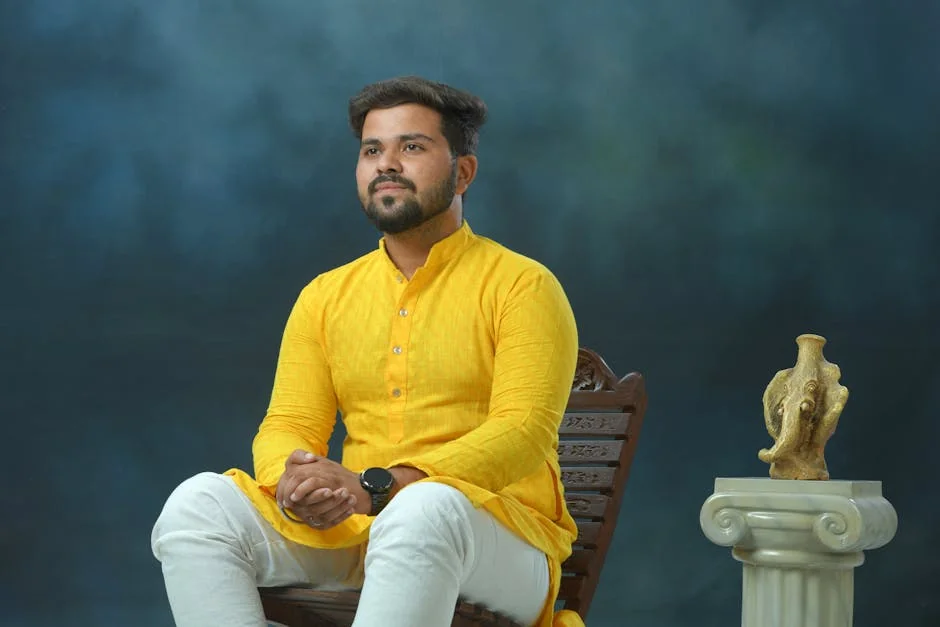You’ve cleared your schedule, found a quiet moment, and are ready to dive into meditation. But the moment you sit down, a single, nagging question arises: How am I actually supposed to sit? If you’ve ever found yourself fidgeting, slouching, or distracted by an aching back just minutes in, you’ve experienced a universal truth—the mind and body are deeply connected. The perfect, peaceful state of meditation begins not with forcing your thoughts to be silent, but with finding a posture that allows your body to be still and supportive.
Contrary to popular belief, there isn't one single "best" way to sit. The best pose to meditate is the one that works uniquely for you—a position that balances alertness with comfort, allowing you to focus inward without being pulled away by physical discomfort. This definitive guide is designed to cut through the confusion. We’ll walk you through seven foundational poses, from classic seated postures to chair meditation and even lying down, providing a clear path to finding your ideal foundation for a deeper, more sustainable practice.
Finding Your Foundation: The Core Principles of a Good Meditation Pose
Before we explore specific postures, it's crucial to understand the why behind them. Every effective meditation position is built on three core principles. Think of these as your checklist for any pose you try.
- Stability: Your posture should feel grounded and solid, like a mountain. You shouldn't be wobbling or using your muscles excessively to hold yourself up. This physical stability translates into mental steadiness.
- Alertness: A good pose keeps you awake and present. It maintains a natural curve in your lower back, which helps keep your mind attentive and engaged. If you're too relaxed or slouched, you risk drifting into drowsiness.
- Comfort: This is the most overlooked principle. While some initial discomfort is normal, a pose should not be agonizing. The goal is a comfortable meditation position that you can maintain for the duration of your session without significant pain. Forcing yourself into an advanced pose is a recipe for distraction and injury.
When these three elements—stability, alertness, and comfort—are in harmony, your body supports your mind. Your physical form becomes a conduit for mindfulness rather than an obstacle. This is the true purpose of your posture for mindfulness.
The 7 Best Poses to Meditate for Every Body and Level
Here are seven of the most effective meditation poses, ranging from the simplest to the more advanced. Each one offers a unique path to achieving that ideal balance.
The Classic: Seated Cross-Legged (Sukhasana)
This is the image that most often comes to mind when people think of meditation. Sukhasana, or "Easy Pose," is the quintessential meditation position for beginners.
- How to do it: Sit on the floor and simply cross your legs at the shins, bringing each foot beneath the opposite knee. It’s that straightforward.
- The key to success: The most important adjustment is often to your hips. Sit on the forward edge of a firm cushion or a folded blanket. This elevates your hips, allowing your knees to drop toward the floor and making it much easier to maintain a neutral, upright spine.
- Best for: Beginners, those with reasonable hip flexibility, and anyone looking for a simple, traditional floor-sitting posture.
The Gold Standard: The Lotus Pose (Padmasana)
Lotus Pose is often portrayed as the pinnacle of meditation postures. While it is a stable and powerful pose, it's not for everyone and should never be forced.
- How to do it: From a seated position, you carefully place each foot on the opposite thigh, close to the hip crease.
- Benefits and cautions: Padmasana creates an incredibly stable, locked-in base that minimizes body movement. However, it requires a great deal of flexibility in the hips, knees, and ankles. Attempting it without the proper mobility can lead to serious injury. It is not a goal to strive for, but a pose to grow into naturally over years of practice.
Seated with Support: Using a Meditation Bench
If cross-legged positions are uncomfortable, a meditation bench (or seiza bench) can be a game-changer. This is one of the most underrated meditation bench benefits.
- How to do it: Kneel on the floor and place the bench over your calves. You then sit back on the bench, which supports your entire body weight.
- Why it works: The bench allows you to maintain a natural, neutral spinal alignment with incredible ease. It takes all the pressure off your ankles, knees, and hips, making it an excellent comfortable meditation position for those with flexibility limitations.
- Best for: People with tight hips or knee/ankle pain, and anyone seeking an upright yet fully supported posture.
Chair Meditation: Perfect for the Office or Limited Mobility
Never underestimate the power of meditating in a chair. It is a completely valid and highly effective way to practice, especially for those with physical limitations or for integrating mindfulness into a workday.
- How to do it: Sit toward the front half of a chair, ensuring your feet are flat on the floor. If your feet don't reach, place a pillow or books under them. Avoid leaning against the backrest to maintain alertness. You can place a cushion or rolled-up towel behind your lower back for support.
- Posture tips: Keep your spine long and your chin slightly tucked. Your hands can rest on your thighs.
- Best for: Office workers, seniors, anyone with significant mobility issues, or those recovering from injury.
Kneeling in Comfort: The Hero Pose (Virasana)
Hero Pose is another excellent kneeling alternative that can be more accessible than a bench for some.
- How to do it: Kneel on the floor with your knees together and your feet slightly wider than your hips. Sit back between your feet.
- Making it comfortable: If your hips don't comfortably reach the floor, sit on a meditation block or a stack of books. The height of the support should allow you to sit without pinching in your knees or ankles.
- Best for: People who find cross-legged poses uncomfortable but have healthy knees.
Corpse Pose (Savasana): The Power of Lying Down
Yes, you can meditate lying down. While it comes with a higher risk of falling asleep, meditating lying down is a powerful practice for deep relaxation and body scans.
- How to do it: Lie flat on your back on a mat or carpet. Let your legs extend long and relax out to the sides. Place your arms a few inches away from your body with palms facing up.
- Staying alert: To maintain alertness, you can keep your knees bent with feet flat on the floor, or place a thin pillow under your head. Avoid meditating in your bed, as your brain associates it with sleep.
- Best for: Evening meditation, body scan practices, those with back pain that prevents sitting, or as a counter-pose to a long day of sitting.
Walking Meditation: Mindfulness in Motion
A "pose" doesn't have to be static. Walking meditation is a profound practice that brings mindfulness into action.
- How to do it: Find a quiet path about 10-20 feet long. Walk slowly and deliberately, focusing all your attention on the physical sensations of movement—the lifting of your foot, the swinging forward, the placing of the heel, and the shifting of weight.
- The posture: Keep your spine upright and your gaze soft, looking a few feet ahead. Your hands can be clasped in front or behind you, or simply rest at your sides.
- Best for: Those who find sitting still unbearably restless, as a break between seated sessions, or for integrating mindfulness into daily life.
How to Choose the Right Meditation Pose for You
With all these options, how do you pick? Your choice should be a practical one, based on your body and your circumstances. Ask yourself these questions:
- What is my flexibility like? If your hips and knees are tight, start with a chair or a kneeling bench. There is no virtue in suffering through a cross-legged pose.
- Do I have any injuries or chronic pain? Always prioritize your physical well-being. A chair or supported lying position is often the safest choice.
- What is my goal for this session? For an energizing morning practice, a seated pose is ideal. For winding down in the evening, Savasana might be perfect. If you're unsure, our guide on the best time to meditate can help you align your practice with your energy levels.
- Where will I be meditating? Your environment matters. Meditating in a chair at the office is a practical adaptation.
The best meditation position for beginners is almost always the one that feels the most sustainable for 5-10 minutes. Experiment without judgment. Your perfect pose might change from day to day.
Beyond the Sit: Perfecting Your Posture and Hand Positions (Mudras)
Once you've chosen your base pose, you can refine your alignment and explore the subtle energy of hand gestures, known as meditation mudras.
Perfecting Your Postural Alignment:
- Spine: Imagine a string gently pulling the crown of your head toward the ceiling. Your spine should feel long and naturally curved, not stiff like a soldier at attention.
- Chin: Gently tuck your chin slightly toward your chest. This lengthens the back of your neck.
- Shoulders: Roll your shoulders up toward your ears, then back and down, letting your shoulder blades settle down your back.
- Hands: You can rest your hands on your knees, palms up or down, or place them in your lap.
An Introduction to Meditation Mudras:
Mudras are symbolic hand gestures that can help channel energy and deepen concentration.
- Chin Mudra (Gesture of Consciousness): This is the most common mudra. Rest your hands on your knees, palms up. Gently touch the tip of your thumb to the tip of your index finger, while the other three fingers remain extended. This symbolizes the connection of individual consciousness with universal consciousness.
- Dhyana Mudra (Gesture of Meditation): Place your right hand in your lap, palm facing up. Rest your left hand on top of it, also palm up, and gently touch the tips of your thumbs together. This creates a beautiful circle of energy and is a classic gesture for seated meditation.
Troubleshooting Common Meditation Pose Problems
It's normal to encounter physical challenges. Here’s how to solve the most common issues.
- "My legs fall asleep or hurt." This is usually a sign of compressed nerves or reduced blood flow. The solution is almost always to elevate your hips higher with more cushions. If the problem persists, switch to a chair or bench. It's okay to gently adjust or change positions during your session.
- "I get back pain when meditating." This often stems from weak core muscles or slouching. Focus on using a cushion to tilt your pelvis forward, creating a natural lumbar curve. Strengthening your core outside of meditation can also make a world of difference. For immediate relief, try meditating in a chair with back support.
- "I feel too restless to sit still." This is a mental challenge manifesting physically. First, ensure your posture is truly comfortable. Then, acknowledge the restlessness without judgment and gently bring your focus back to your breath. If it's overwhelming, try a walking meditation instead. Dealing with restlessness is a core part of the practice, and you can find more strategies in our article on the best way to learn how to meditate.
- "I keep falling asleep." This is a common issue, especially when meditating lying down or in a slumped seated position. Check your posture—are you truly alert? Try meditating with your eyes slightly open, with a soft gaze downward. A cooler room or meditating at a different time of day (not right after a meal) can also help.
Your Journey Begins Now: Integrating the Best Pose into Your Practice
The search for the best pose to meditate is a personal exploration, not a destination. It’s about building a supportive relationship with your body, one sitting at a time. Perfection is not the goal; consistency is.
Start where you are. Use the principles of stability, alertness, and comfort as your guide. Experiment with one or two poses from this guide that feel accessible. If you're just beginning your journey, our guide on how to meditate for beginners at home can help you build a complete practice from the ground up. Remember that the most advanced practitioner is not the one who can twist into Lotus Pose, but the one who has found a posture that allows them to return to their practice, day after day, with a sense of ease and presence.
Your foundation awaits. Find your pose, take a deep breath, and begin.
In our exploration of meditation postures, the central message is clear: the best pose is the one that allows you to practice consistently. Whether seated in a chair, cross-legged on a cushion, or even lying down, physical stability is the true foundation for mental stillness. The ideal posture balances an alert, upright spine with a sense of deep relaxation, preventing both drowsiness and strain. Ultimately, the goal is not to achieve a perfect, painless form, but to find a sustainable position where the body can be forgotten, allowing awareness to turn inward. Do not let the pursuit of an idealized posture become a barrier to your practice itself. Begin with what feels accessible today, using props for support as needed, and trust that your comfort and alignment will naturally deepen over time. Your meditation journey is a personal one, and the most profound progress starts from a place of compassionate self-acceptance. Find your supportive pose, settle in, and begin.



